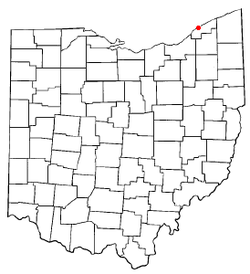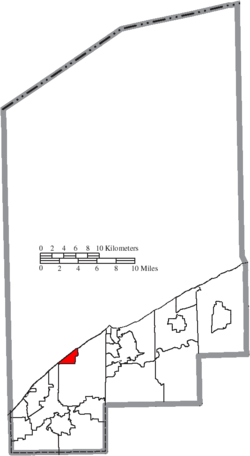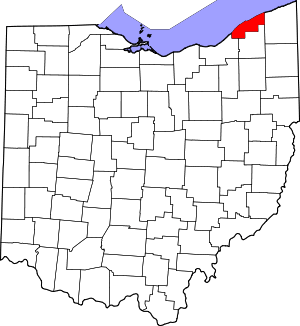Mentor-on-the-Lake, Ohio
Mentor-on-the-Lake is a city in Lake County, Ohio, United States. The population was 7,443 at the 2010 census.
Mentor-on-the-Lake, Ohio | |
|---|---|
 Location of Mentor-on-the-Lake, Ohio | |
 Location of Mentor-on-the-Lake in Lake County | |
| Coordinates: 41°42′49″N 81°21′53″W | |
| Country | United States |
| State | Ohio |
| County | Lake |
| Government | |
| • Mayor | David R Eva |
| Area | |
| • Total | 1.65 sq mi (4.28 km2) |
| • Land | 1.61 sq mi (4.18 km2) |
| • Water | 0.04 sq mi (0.10 km2) |
| Elevation | 620 ft (189 m) |
| Population | |
| • Total | 7,443 |
| • Estimate (2019)[4] | 7,390 |
| • Density | 4,581.53/sq mi (1,768.78/km2) |
| Time zone | UTC-5 (Eastern (EST)) |
| • Summer (DST) | UTC-4 (EDT) |
| ZIP code | 44060 |
| Area code(s) | 440 |
| FIPS code | 39-49098[5] |
| GNIS feature ID | 1056421[2] |
| Website | www |
History
Originally part of Mentor Township, the village was established October 22, 1924. The U.S. Census for 1970 recorded the official population as being over 5,000 and thus it became an incorporated city on February 12, 1971.[6]
A vast majority of the land that comprises Mentor-On-The-Lake was originally owned and deeded as the Dickey-Moore tract and extended all the way south beyond U.S. Route 20 in the city of Mentor. A remnant of this era is a property known as Mooreland which was once owned by the Moore family and is situated on land that now houses Lakeland Community College.
Mentor-on-the-Lake shares many services with the nearby city of Mentor, including postal service.
Geography
Mentor-on-the-Lake is located at 41°42′49″N 81°21′53″W (41.713746, -81.364702).[7]
According to the United States Census Bureau, the city has a total area of 1.65 square miles (4.27 km2), of which 1.61 square miles (4.17 km2) is land and 0.04 square miles (0.10 km2) is water.[8]
Demographics
| Historical population | |||
|---|---|---|---|
| Census | Pop. | %± | |
| 1930 | 230 | — | |
| 1940 | 538 | 133.9% | |
| 1950 | 1,413 | 162.6% | |
| 1960 | 3,290 | 132.8% | |
| 1970 | 6,517 | 98.1% | |
| 1980 | 7,919 | 21.5% | |
| 1990 | 8,271 | 4.4% | |
| 2000 | 8,127 | −1.7% | |
| 2010 | 7,443 | −8.4% | |
| Est. 2019 | 7,390 | [4] | −0.7% |
| Sources:[5][9][10][11] | |||
2010 census
At the 2010 census there were 7,443 people in 3,197 households, including 2,012 families, in the city. The population density was 4,623.0 inhabitants per square mile (1,785.0/km2). There were 3,461 housing units at an average density of 2,149.7 per square mile (830.0/km2). The racial makeup of the city was 95.6% White, 1.8% African American, 0.1% Native American, 1.0% Asian, 0.2% from other races, and 1.3% from two or more races. Hispanic or Latino of any race were 1.4%.[3]
Of the 3,197 households 29.2% had children under the age of 18 living with them, 44.3% were married couples living together, 13.3% had a female householder with no husband present, 5.3% had a male householder with no wife present, and 37.1% were non-families. 30.7% of households were one person and 11.2% were one person aged 65 or older. The average household size was 2.33 and the average family size was 2.90.
The median age was 40.3 years. 21.7% of residents were under the age of 18; 8.5% were between the ages of 18 and 24; 26.6% were from 25 to 44; 29.1% were from 45 to 64; and 14.1% were 65 or older. The gender makeup of the city was 49.0% male and 51.0% female.
2000 census
At the 2000 census there were 8,127 people in 3,304 households, including 2,230 families, in the city. The population density was 4,976.3 people per square mile (1,925.1/km2). There were 3,405 housing units at an average density of 2,084.9 per square mile (806.6/km2). The racial makeup of the city was 97.15% Caucasian, 0.81% African American, 0.07% Native American, 0.65% Asian, 0.30% from other races, and 1.02% from two or more races. Hispanic or Latino of any race were 1.19%.[5] 18.3% were of German, 16.3% Irish, 14.0% Italian, 7.7% Polish, 7.4% English and 6.2% American ancestry according to Census 2000.
Of the 3,304 households 31.6% had children under the age of 18 living with them, 52.6% were married couples living together, 10.7% had a female householder with no husband present, and 32.5% were non-families. 26.6% of households were one person and 8.0% were one person aged 65 or older. The average household size was 2.46 and the average family size was 3.00.
The age distribution was 24.6% under the age of 18, 8.6% from 18 to 24, 33.9% from 25 to 44, 22.4% from 45 to 64, and 10.5% 65 or older. The median age was 35 years. For every 100 females, there were 94.8 males. For every 100 females age 18 and over, there were 91.7 males.
The median household income was $44,871 and the median family income was $50,802. Males had a median income of $38,049 versus $26,168 for females. The per capita income for the city was $20,717. About 4.2% of families and 5.7% of the population were below the poverty line, including 6.8% of those under age 18 and 4.6% of those age 65 or over.
Education
Residents in Mentor-on-the-Lake are zoned to Mentor Public Schools.[12] Most students are zoned to Lake Elementary School, while some are zoned to Orchard Hollow Elementary School.[13] Almost all students are zoned to Shore Middle School, with a small portion of the city zoned to Memorial Middle School.[14] All students are zoned to Mentor High School.
References
- "2019 U.S. Gazetteer Files". United States Census Bureau. Retrieved July 28, 2020.
- "US Board on Geographic Names". United States Geological Survey. 2007-10-25. Retrieved 2008-01-31.
- "U.S. Census website". United States Census Bureau. Retrieved 2013-01-06.
- "Population and Housing Unit Estimates". Retrieved May 21, 2020.
- "U.S. Census website". United States Census Bureau. Retrieved 2008-01-31.
- City of Mentor-on-the-Lake: History Archived 2008-05-13 at the Wayback Machine from the official city website
- "US Gazetteer files: 2010, 2000, and 1990". United States Census Bureau. 2011-02-12. Retrieved 2011-04-23.
- "US Gazetteer files 2010". United States Census Bureau. Archived from the original on 2012-01-25. Retrieved 2013-01-06.
- "Population: Ohio" (PDF). 1930 US Census. U.S. Census Bureau. Retrieved 28 November 2013.
- "Number of Inhabitants: Ohio" (PDF). 18th Census of the United States. U.S. Census Bureau. 1960. Retrieved 17 May 2020.
- "Ohio: Population and Housing Unit Counts" (PDF). U.S. Census Bureau. Retrieved 22 November 2013.
- "About Our District." Mentor Public Schools. Retrieved on June 1, 2017.
- "2015 Elementary School Attendance Areas." Mentor Public Schools. Retrieved on June 1, 2017.
- "2015 Middle School Attendance Areas." Mentor Public Schools. Retrieved on June 1, 2017.
